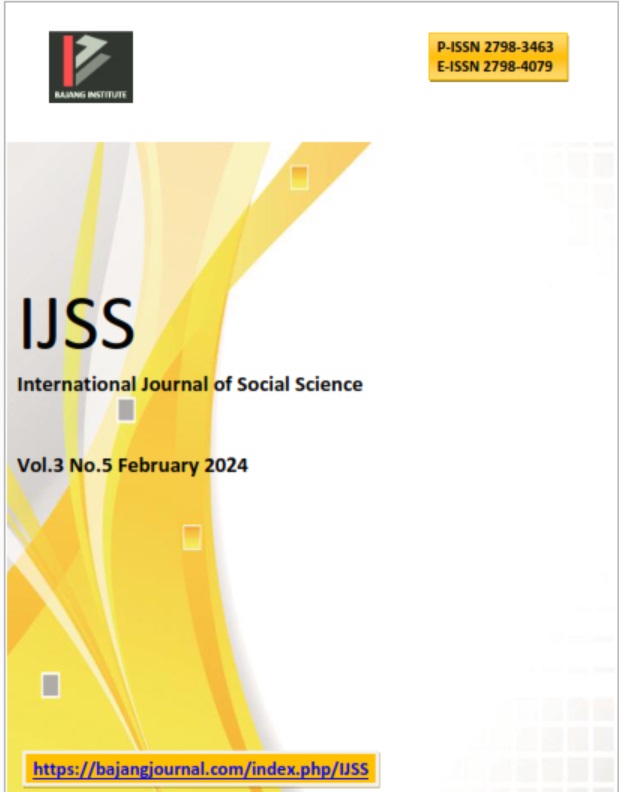OPTIMIZATION OF RETENTION POND IN FLOOD CONTROL EFFORTS IN PEKANBARU (URBAN FLOOD SYSTEM IMPROVEMENT PROJECT)
DOI:
https://doi.org/10.53625/ijss.v3i5.7425Keywords:
Retention Ponds,, Urban Flooding, Spatial DistributionAbstract
This research aims to optimize the function of retention ponds as part of the urban flood control improvement project in Pekanbaru. Evaluation was conducted on the capacity and efficiency of retention ponds, with a focus on spatial distribution, sustainability, and environmental impact. The findings of this study provide a foundation for formulating concrete and data-driven improvement recommendations. The spatial distribution of retention ponds is crucial in understanding their effectiveness in mitigating flood risks. Evaluation of the actual capacity of retention ponds provides an overview of their ability to accommodate excess rainwater, while efficiency identifies factors for enhancement and improvement. Improvement recommendations include increasing capacity, implementing advanced technology, and developing data-driven solutions. Involving stakeholders, including local government, research institutions, and the community, is a strategic step to ensure successful implementation. The application of sensors and geographic information systems (GIS) can enhance the effectiveness of retention pond operational management. Sustainability of solutions is realized through routine maintenance, performance monitoring, and multi-stakeholder collaboration. This research significantly contributes to urban flood management in Pekanbaru by providing concrete, data-driven recommendations for the retention pond system.
References
Alzuhri, R., Ishak, I., & Herista, F. (2022). TINJAUAN PERENCANAAN KOLAM RETENSI TABEK TUHUA PANGANAK KOTA BUKITTINGGI. Ensiklopedia Research and Community Service Review, 2(1). https://doi.org/10.33559/err.v2i1.1413
Ayalew, T. B., Krajewski, W. F., & Mantilla, R. (2015). Insights into Expected Changes in Regulated Flood Frequencies due to the Spatial Configuration of Flood Retention Ponds. Journal of Hydrologic Engineering, 20(10). https://doi.org/10.1061/(asce)he.1943-5584.0001173
Baskoro, B. A., Sisinggih, D., & Marsudi, S. (2018). Perencanaan Kolam Retensi Sebagai Usaha Mereduksi Banjir Sungai Citarum Hulu, Kabupaten Bandung. Jurnal Mahasiswa Jurusan Teknik Pengairan, 1(2).
Bowes, B. D., Tavakoli, A., Wang, C., Heydarian, A., Behl, M., Beling, P. A., & Goodall, J. L. (2021). Flood mitigation in coastal urban catchments using real-time stormwater infrastructure control and reinforcement learning. Journal of Hydroinformatics, 23(3). https://doi.org/10.2166/HYDRO.2020.080
Harmani, E., & Soemantoro, M. (2017). Kolam Retensi Sebagai Alternatif Pengendali Banjir. Jurnal Teknik Sipil Unitomo, 1(1).
Hasan, F., Rahmana, A., Komarudin, U., & Setyadi, A. (2021). Flood Control in Pajang Stowage Tangerang City with Zero Run Off Concept. Review of International Geographical Education Online, 11(6). https://doi.org/10.48047/rigeo.11.06.32
Keyvanfar, A., Shafaghat, A., Ismail, N., Mohamad, S., & Ahmad, H. (2021). Multifunctional retention pond for stormwater management: A decision-support model using Analytical Network Process (ANP) and Global Sensitivity Analysis (GSA). Ecological Indicators, 124. https://doi.org/10.1016/j.ecolind.2020.107317
Maulani, I., & Susetyaningsih, A. (2022). Analisis Dampak Lingkungan Kolam Retensi Cieunteung di Kecamatan Baleendah Kabupaten Bandung. Jurnal Konstruksi, 20(1). https://doi.org/10.33364/konstruksi/v.20-1.921
Mistoro, N. H., & Saraswati, S. P. (2019). Design and modification of horizontal-flow roughing filter as water treatment at UGM retention pond. E3S Web of Conferences, 76. https://doi.org/10.1051/e3sconf/20197602002
Pramono, A. N., & Saputro, P. T. (2021). Efektivitas Kolam Retensi Terhadap Pengendalian Banjir. G-SMART, 4(2). https://doi.org/10.24167/gsmart.v4i2.2331
Ramos, H. M., Teyssier, C., & López-Jiménez, P. A. (2013). Optimization of Retention Ponds to Improve the Drainage System Elasticity for Water-Energy Nexus. In Water Resources Management (Vol. 27, Issue 8). https://doi.org/10.1007/s11269-013-0322-3
Suryalfihra, S. I., Rahmadi, D., & Prasetya, F. V. A. S. (2021). Studi Volume Kapasitas Air Dengan Menggunakan Single Beam Echosounder Di Area Kolam Retensi Kelurahan Air Hitam Kota Samarinda. Buletin Poltanesa, 22(1). https://doi.org/10.51967/tanesa.v22i1.473
Tawakkal, A., Wahyudi, H., Indriyani, D., & Zuhdy, A. Y. (2022). Pengembangan Kolam Retensi Dalam Upaya Mereduksi Banjir Kali Jeroan Kabupaten Madiun. Jurnal Teknologi Dan Manajemen, 3(2). https://doi.org/10.31284/j.jtm.2022.v3i2.3161
Udiana, I. M., Ramang, R., Simatupang, P. H., & Bella, R. A. (2020). Perencanaan Kolam Retensi untuk Mengatasi Banjir di Kecamatan Oebobo Kota Kupang. Jurnal Teknik Sipil, IX(2).
Valenca, R., Garcia, L., Espinosa, C., Flor, D., & Mohanty, S. K. (2022). Can water composition and weather factors predict fecal indicator bacteria removal in retention ponds in variable weather conditions? In Science of the Total Environment (Vol. 838). https://doi.org/10.1016/j.scitotenv.2022.156410
Verstraeten, G., & Poesen, J. (1999). The nature of small-scale flooding, muddy floods and retention pond sedimentation in central Belgium. Geomorphology, 29(3–4). https://doi.org/10.1016/S0169-555X(99)00020-3
Yadav, S., & Goyal, V. C. (2022). Current Status of Ponds in India: A Framework for Restoration, Policies and Circular Economy. Wetlands, 42(8). https://doi.org/10.1007/s13157-022-01624-9
Z, S. (2022). KOLAM RETENSI SEBAGAI UPAYA PENGENDALIAN BANJIR PADA DAERAH ALIRAN SUNGAI BATANG PANGIAN. Rang Teknik Journal, 5(1). https://doi.org/10.31869/rtj.v5i1.2856
Zevri, A. (2019). Desain Kolam Retensi Pada Daerah Aliran Sungai Bekala. Jurnal Rekayasa Sipil (JRS-Unand), 15(2). https://doi.org/10.25077/jrs.15.2.90-102.2019
Downloads
Published
How to Cite
Issue
Section
License
Copyright (c) 2024 Erni Yulianti, Eko Prasetyo

This work is licensed under a Creative Commons Attribution 4.0 International License.

















